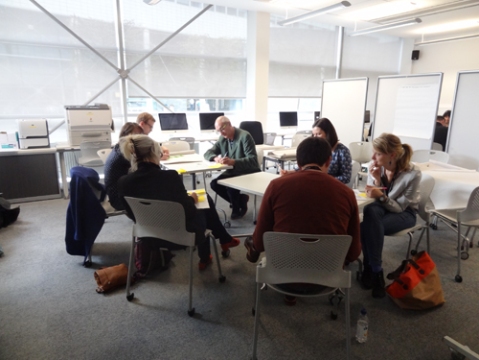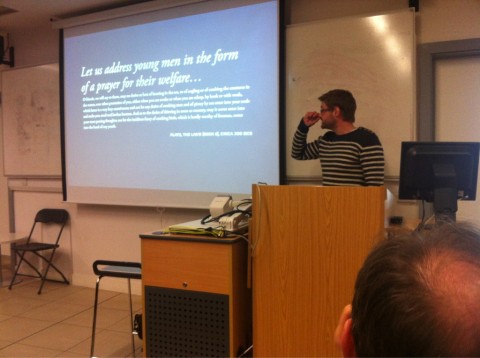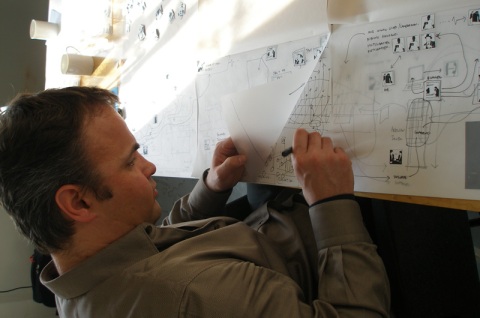Call for submissions – Praxis and Poetics Research Through Design 2013 Conference
February 15, 2013 § Leave a comment
We are excited to invite submissions for the first International bi-annual Praxis and Poetics: Research Through Design conference, hosted by Northumbria University at the BALTIC Centre for Contemporary Art, 3rd – 5th September 2013. The conference is based around a curated exhibition of design research, accompanied by a maximum of a 4-page paper for each submission.
The first Research Through Design conference aims to explore multi-textural opportunities for presenting and discussing non discipline specific research through design and resists the temptation to adopt a traditional format for both paper submission and presentation in favour of an exhibition of design research accompanied by roundtable presentations and discussions in ‘rooms of interest’. The exhibition will be used as a platform to present and express outcomes of research, demonstrate examples of research enquiries and generate debate about the role of making in design research.
The conference of theme of Praxis and Poetics represents the different modes and approaches to practice as well as a larger ethos around content related to poetics, beauty and grace.
Abstract submission deadline: March 25th, 2013. All submissions will be double peer reviewed and the exhibition will be curated. You can find out more about the set up and process of RTD at www.northumbria.ac.uk/praxisandpoeticsRTD.
RTD will be run alongside the Design of Pleasurable Products and Interfaces (DPPI) 2013 conference. The full conference website will be up and running in a couple of weeks and will be publicised soon.
For general conference enquiries please email ad.RTDconference@northumbria.ac.uk.
Exploring Research through Design practice – symposium roundup
April 18, 2012 § 2 Comments
I think its safe to say that the 1 day symposium focused on bringing together different view points on practice-based design research was well received and got participants talking/discussing/disagreeing/agreeing throughout the day. There is a storify page of the day. My quick reflections and thoughts of each speaker are listed below.
Session 1: Models of Design Research
The different purposes of design research – Dr. Daniel Fallman
Associate professor in the Department of Informatics at Umea University and Studio Director of Interactive Institute Umeå
Daniel introduced his triangular model of interaction design research that has evolved at the Umeå Institute of Design in recent years, and has been guiding their interaction design research efforts and their Ph.D. education. The key points I took away were:
- The 3 areas (Design Practice, Explorative Design & Design Studies) are not mutually exclusive. They are facets of a design research project. A design researcher can only put on 1 hat on at a time, when they are designing for a client, they are placed firmly in the Design Practice triangle. When they choose to reflect and perhaps derive knowledge from the project, they metaphorically put on the ‘Design Studies’ hat.
- You can’t put on all 3 hats at the same time.
- It is a working model, not a framework model. Used to understand and reflect, not a static theory of design research.
- Model used with Masters students and PhD students but not introduced at UG.
- Useful tool to bridge the gap between UG (lacking research skills and have limited interest in theory) and Postgrad.
————————————————————————————————————————————————–
Towards a Critical Engagement with the Possible – Dr. Thomas Binder
Associate Professor, The Danish Design School
Thomas’s central question is how do we construct knowledge in design, how can we be knowledgeable? He spoke about the importance of craftsmanship and the value of experiments in a design process. Thomas argues strongly for the recognition that knowledge resides in a design outcome. Thomas referred to Stuart Bailey’s paper (2008) discussing the purpose of design schools. Bailey proposes that there are 3 historical models of design schools. I have placed each model with the what, how and why of design, based on what I have interpreted from Thomas’s talk.
The ‘what’ of design – Academy tradition (before the Bauhaus): Talent, Techniques & Imitation
The ‘how’ of design – Bauhaus school: Creativity, Media & Invention
The ‘why’ of design – Contemporary school: Attitude, Practice & Deconstruction
The key points I took away were:
- As design educators, we must help students formulate a world view which calls for engagement and a certain reflective approach
- Design as way of inquiry is a way of knowing the world
- Designer use many methods, but relatively few methodologies (through the XLab project where 3 PhD studies were examined)
- Experiments are at the heart of design research
- In design research, we engage without necessary providing solutions
- Design as a means as well as an object
————————————————————————————————————————————————–
Session 2: The Roles of Practice in Design Research
Doing design as a part of doing research– Professor Pieter Jan Staapers
Professor of Design Techniques, Delft University of Technology
Pieter started off by firstly defining what he means by design research in order to avoid any confusion. He define it as ‘research using design skills’. He uses Horváth’s description of different types of research (see diagram below, courtesy of PJ Staapers), in which he differentiates between design-inclusive research (testing hypothesis with prototypes) with research through design (developing prototypes as exploration).
The value of research can be answer by asking these 3 question:
- What new knowledge is generated (scientific value)
- How can we do things better (engineering/design value)
- Why should this be done (societal benefit)
The key points I took away:
- Theory, technology, and practice go hand in hand
- Prototypes have many values (especially when using them to explore possibilities)
- Design research have to integrate many areas
- Sometimes generalised insights can lead to spinoff ideas
————————————————————————————————————————————————–
Handmade Knowledge: the new challenge for craft research – Professor Mike Press
Programme Director, Design & Craft, Duncan of Jordanstone College of Art & Design, Dundee University
Illustration of Mike’s talk by Malcolm Jones
Mike introduces himself as a having a somewhat schizophrenic career and interest, spanning craft, design and crime to design management. He laments the fact that although the UK’s RAE (Research Assessment Exercise) in the past have valued design management type of publication, he feels that it is craft knowledge and research that has actually made more of an impact to society. He argues for the recognition of handmade knowledge, not knowledge about crafting objects but about crafting knowledge. He showed examples of work where researchers from a craft background have applied their knowledge and expertise into other domains (generally using technology) that are illustrating what he calls a ‘quiet revolution’ in raising the profile of craft research. His examples include Gordan Burnett, Drummond Masterson, Justin Marshall, Professor Jane Harris, Professor Elaine Sherritt, Hazel White and our very own Dr Jayne Wallace.
Key points I took away:
- Design researchers need to value what they do and not just aim to be a ‘bad social scientist’
- Craft stories have value, we just need to know how to tell it in a straightforward manner
- The role of craft knowledge is often ignored in the scientific stories of discovery
- We need to teach and encourage designers of the future to act as sociable expert rather than become an anti-social expert (referring to Sennet’s The Craftsman)
On Craft and Being Crafty: Human Behaviour as the Object of Design. Ben Singleton
March 29, 2012 § Leave a comment
After a few weeks hiatus, our practice-based design lectures are back on track. We had Ben Singleton (@benedict), a Northumbria University PhD candidate to talk about his research on being ‘crafty‘. He offers a thought-provoking alternate (and forgotten) account of designing with people. He brings in the concept of ‘metis’ which in Greek means a quality that combined wisdom and cunning, linking this with original suspicions about design (and designers) and using these interlinking concepts to build an alternate argument to inform designing services with people. If this sounds very intriguing, his storify link is here. Image courtesy of Louise Taylor.
‘Exploring Research Through Design’ symposium registration now open
March 7, 2012 § Leave a comment
The ‘Exploring Research through Design’ one-day symposium is now open for registration. As places are limited, we would appreciate people signing up and registering their interest. To remind you of the fantastic line-up we have for the event, here are the speakers’s profile.
Objects, Environment and Meaning: Stuart Walker
March 7, 2012 § Leave a comment
It was another thought-provoking and insightful presentation by Professor Stuart Walker today. He spoke about practice-based research in relation to design for sustainability. Although notes on the presentation would not do it justice, we have a storify version kindly shared by Vicky Teinaki (@vickytnz). Stuart not only presented his interesting propositional design objects, he also presented his thesis on his quadruple bottom line (a reimagined triple bottom line) framework which helps us understand the origins and purpose of his propositional objects. More importantly for our design research community, he clearly articulated his research through design process. You can find out more about his work through his two books, ‘Sustainable by Design‘ and ‘Spirit of Design‘.
Daniella Petrelli & Atau Tanaka’s Storify link
March 1, 2012 § Leave a comment
We had our first external speakers contributing into our lecture series. Although it wasn’t planned, the theme of the day was ‘sound’. Dr Daniella Petrelli, an Interaction Design researcher from Sheffield Hallam University started us off the session by taking us through her recent project, ‘Sound and Memory’. While Professor Atau Tanaka, Chair of Digital Media at the Culture Lab in Newcastle University spoke about the role of Instruments, Performance & Participation in creative practice in research. We have compiled Louise Taylor’s (@sugaredeggs) tweets during their presentations in a storify page. Fuller description of their talk will follow soon.
Steve Gibson’s Storify Link
February 22, 2012 § Leave a comment
Steve Gibson showed us he can dance as well as create very immersive environments in his talk today! Nice moves Steve! We are a bit behind in our presentation write up…but hopefully we will be getting Jayne’s and Steve’s talk summarised next week. In the meantime, here is Vicky Teinaki’s (@vickytnz) tweets compiled in Storify for your perusal pleasure!
I love our talented PhD students – Malcolm Jones who is pursuing a PhD that focuses on making scenarios more worthwhile using ‘narrative modelling’ as a research approach has sketched out the ‘content’ of the talk. His sketch of Steve’s talk ‘Spatial and Physical Media’ is posted below.
Jayne Wallace Storify’s Link
February 15, 2012 § Leave a comment
We had our very own Jayne Wallace presenting her work as part of our lecture-based series today. The write up of her presentation will appear next week. In the meantime, here is Vicky Teinaki’s (@vickytnz) tweets compiled in Storify for your perusal pleasure!
Sketch of Jayne’s talk by Malcolm Jones below.
Summary of Professor Paul Rodger’s Talk
February 15, 2012 § Leave a comment
by Louise Taylor
Paul Rodgers (@paulstweet) Professor in Design Issues at Northumbria University’s School of Design, was the inaugural speaker in this new series of lectures exploring ‘The Role of Practice in Design Research’.
Paul began by stating that he finds it difficult to categorise his work, but (when forced to) calls it an exploration of sociocultural design issues. The main method he employs is simply ‘talking to people’ and it is his belief that while in the past designers needed to sketch to see, today they more often need the skills to listen and to understand what people say (and don’t say).
To support this statement Paul took the audience of Masters students, practicing designers and academics on a whistle-stop tour of his most recent work, beginning with the Design Fairground.
As part of the Six Cities Festival Paul and colleagues from Napier University held a unique 3-day event in Edinburgh city centre to engage the public with the world of design. Putting a designerly spin on traditional fairground games such as hook-a-duck, peep shows and the coconut shy, Paul’s contribution was a ‘Rogue’s Gallery’ featuring videos of people describing their most hated products – highlighting the role designers have to play in creating even the most humble of products. The event proved a great success, drawing around a thousand visitors each day into a citywide debate on design.
The next project Paul discussed was his book publication ‘Inspiring Designers’ in which he explored whether designers are made or developed, and how their level of cultural engagement influences their work. As part of his research Paul travelled the world record video interviews with superstar designers such as Ron Arad. Although the filming was only undertaken to inform the writing of the book, a request was made for the videos themselves to be exhibited in Glasgow’s prestigious Lighthouse arts venue. This was Paul’s example of how material that a designer may only consider a ‘prompt’ can actually turn out to be a valuable standalone research output – which was an extremely useful observation for the many design practitioners in the audience.
Other projects Paul presented included a one-day symposium exploring the merging of creative disciplines, which drew international visitors and led to the publication of his recent book ‘Digital Blur’; and an AHRC-funded series of workshops investigating how technology embedded in universities could be used by local companies.
Next up was a project described by Paul as his ‘most interesting’ to date: an AHRC and ESRC –funded project exploring the social media that creative professional use in their everyday practice.
Utilising a creative reflection probe technique, designers from Greyworld and Jason Bruges Studio and fashion designer Niki Taylor documented their design processes on paper, before laying tracing paper over the top of the maps and adding in the layers of social media they used, and how those interactions impacted upon the project outcomes. The intricate maps produced during this activity became valuable artefacts to the designers, who so rarely have the opportunity to articulate their process when they are buried in the middle of it. In addition the act of interviewing and recording their map-making presented the designers with new opportunities to improve their design processes, as in one case where the act of mapping identified that test material produced during projects could serve double-duty as promotional material for the company.
Despite the unexpected additional value generated through this research activity, the work remains unpublished with Paul stating that he presented it here as an example of the fact that ‘you can do good work, but it can be hard to find an outlet for it’, in sharp contrast to the Inspiring Designers video material which was never intended for public consumption but found an audience of its own.
In summary Paul presented his current and forthcoming work, including ‘Trump’ an EPSRC-funded collaboration to develop a mobile platform for the management of chronic illnesses, piloting in rural areas of India, Aberdeen and Northumberland; and a playfully provocative project seeking to answer the serious question of ‘what is design?’ through a website (We Are All Designers) and it’s ‘evil twin’ (Are We All Designers?).
The session ended with heated discussions in the audience around how best to define a design practice, and whether definition is needed at all – Paul feels not, and has built his own practice upon identifying interesting and unusual opportunities, and following them in occasionally unexpected directions.
Paul Rodger’s Storify Link
February 9, 2012 § Leave a comment
Professor Paul Rodgers kicked off our lecture series. We will be publishing a more complete summary by Louise Taylor (@sugaredeggs). In the meantime, if you can’t wait, here is a storify version of Louise’s tweets during Paul’s talk.












